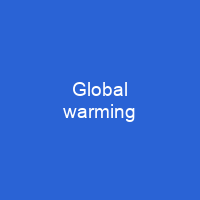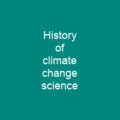Climate change includes both the global warming driven by human emissions of greenhouse gases, and the resulting large-scale shifts in weather patterns. The human cause of climate change is not disputed by any scientific body of national or international standing. The World Health Organization has declared climate change the greatest threat to global health in the 21st century.
About Global warming in brief

The number of warm days and warm nights has increased and increased, with the Medieval Climate Anomaly and Little Ice Age, did not occur at the same time as the high temperatures, but may have reached as high as 2°C in some regions. The Intergovernmental Panel on Climate Change has issued a series of reports that project significant increases in these impacts as warming continues to 1. 5 °C and beyond. Some effects will continue for centuries, including rising sea levels, rising ocean temperatures, and ocean acidification. Many of these effects are already observed at the current level of warming, which is about 1.1°C. Under the Paris Agreement, nations agreed to keep warming well under 2. 0°C by reducing greenhouse gas emissions. However, under those pledges, global warming would reach about 2. 8 C by the end of the century, and current policies will result in about 3. 0 C of warming. Limiting warming to 1 5°C would require halving emissions by 2030, then reaching near-zero emissions by 2050. Mitigation efforts include the development and deployment of low-carbon energy technologies, enhanced energy efficiency, phase-out of coal, reforestation, and forest preservation. Societies are also working to adapt to current and future global-warming effects through improved coastline protection, better disaster management, and development of more resistant crops. Even if efforts to minimize future warming are successful, some effects will still be felt for decades to come, including extinction or relocation of many species.
You want to know more about Global warming?
This page is based on the article Global warming published in Wikipedia (as of Jan. 04, 2021) and was automatically summarized using artificial intelligence.







